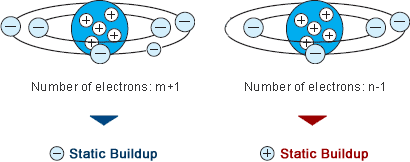Static Electricity in Solids
Static electricity can be generated in solids through contact friction and separation or adhesive stripping of objects. When two solids come into contact and then separate, there is a transfer of electrons between them, resulting in one object becoming positively charged while the other becomes negatively charged. This is known as triboelectric charging, and it is the most common way in which static electricity is generated in solids.
Static Electricity Generated by Solid Contact Friction and Separation
The generation of static electricity through contact friction and separation occurs when two solids rub against each other, causing an exchange of electrons. The extent of the electron exchange and the resulting charge depends on various factors such as the materials involved, the surface area of contact, and the relative humidity of the surrounding air. For example, when a person walks on a carpet, their shoes rub against the carpet, causing an exchange of electrons and resulting in a buildup of static electricity. This can be observed when the person touches a metal object and experiences a static shock.
Static Electricity Generated by Adhesive Stripping of Objects
Static electricity can also be generated when two objects are separated after being stuck together. This is commonly observed when peeling off adhesive tapes or labels. The separation of the two objects causes an exchange of electrons, resulting in one object becoming positively charged while the other becomes negatively charged.
Static Electricity Induction
Static electricity can also be generated through induction. This occurs when a charged object is brought near a neutral object, causing the electrons in the neutral object to shift, resulting in one side of the object becoming positively charged while the other side becomes negatively charged. This is commonly observed when a person brings a charged balloon near their hair, causing their hair to become attracted to the balloon.
Static Electricity in Powders
Static electricity can also be generated in powders. This occurs when the powder particles rub against each other, causing an exchange of electrons and resulting in the powder becoming charged. This can be observed in various industries such as pharmaceuticals, where static electricity can cause issues such as powder clumping and difficulty in dispensing.
Static Electricity in Insulating Liquids
Static electricity can also be generated in insulating liquids. This occurs through double layer charging or flowing static electricity.
Double Layer Charging in Insulating Liquids (Tin Vessels, etc.)
Double layer charging occurs when an insulating liquid is placed in a container made of a conducting material such as tin. The container becomes charged through induction, and the charge is transferred to the liquid through a process known as double layer charging. This results in the liquid becoming charged. This phenomenon is commonly observed in the petroleum industry, where it can cause issues such as equipment damage and explosions.
Flowing Static Electricity
Flowing static electricity occurs when an insulating liquid flows through a pipe or over a surface. This causes an exchange of electrons between the liquid and the surface, resulting in the liquid becoming charged. This phenomenon is commonly observed in industries such as electronics, where it can cause issues such as product contamination and equipment failure.
In general, static electricity is generated through various means, including in solids, powders, and insulating liquids. It is a phenomenon that can have both positive and negative impacts, and it is important to understand how it is generated and how it can be controlled in various industries to prevent issues such as explosions, equipment damage, and product contamination. Various methods can be used to control static electricity, including grounding, ionization, and humidity control. Understanding and controlling static electricity is crucial for ensuring the safety and efficiency of various industrial processes.




Leave a Reply
Want to join the discussion?Feel free to contribute!